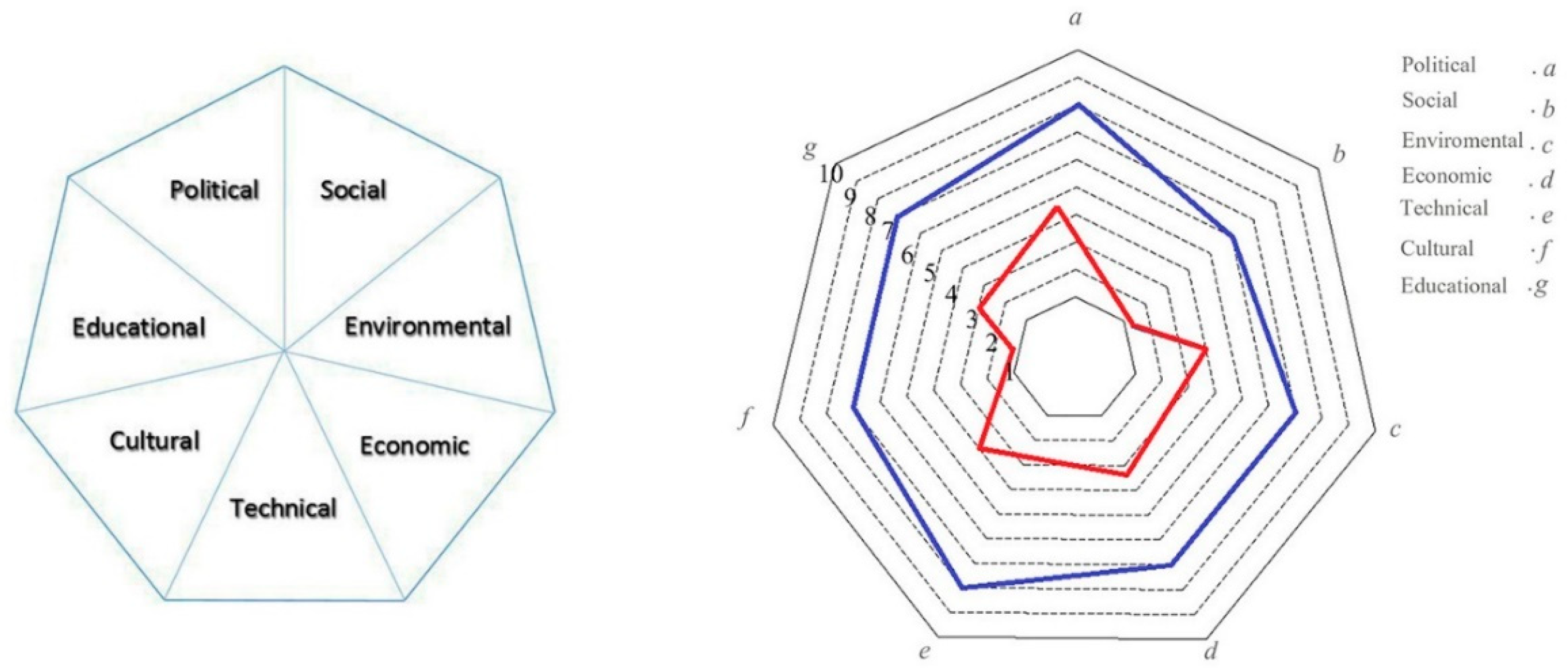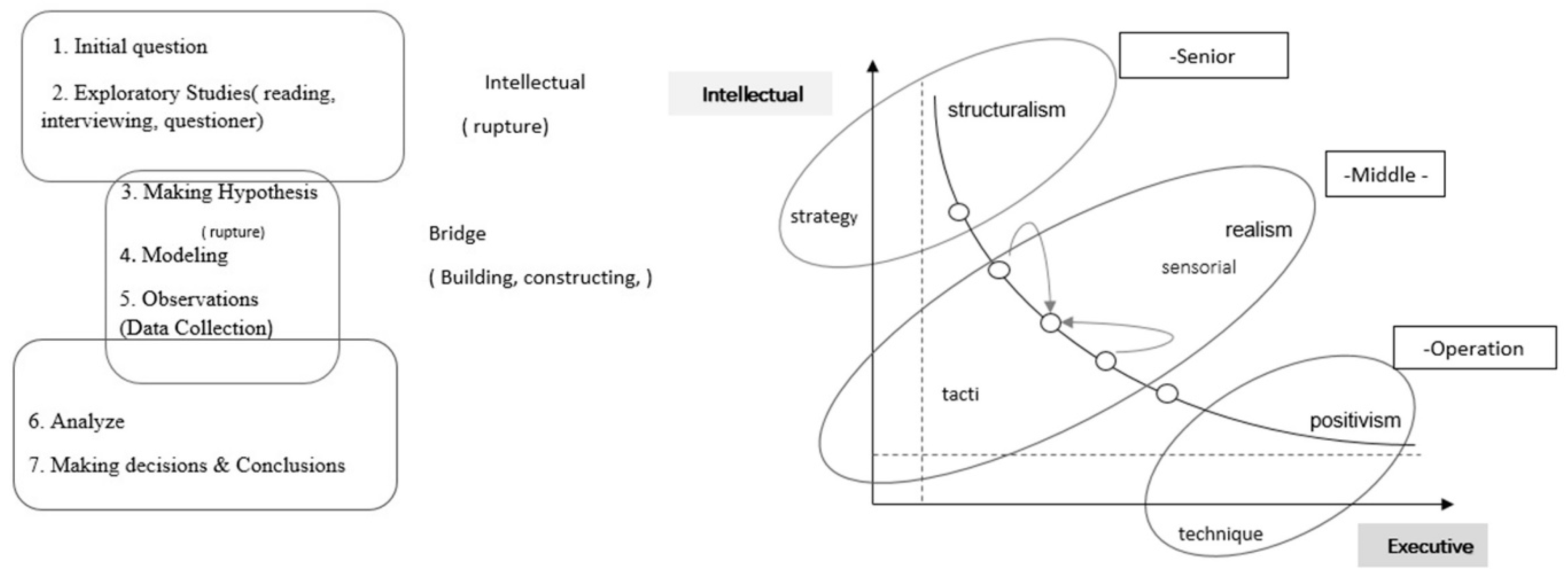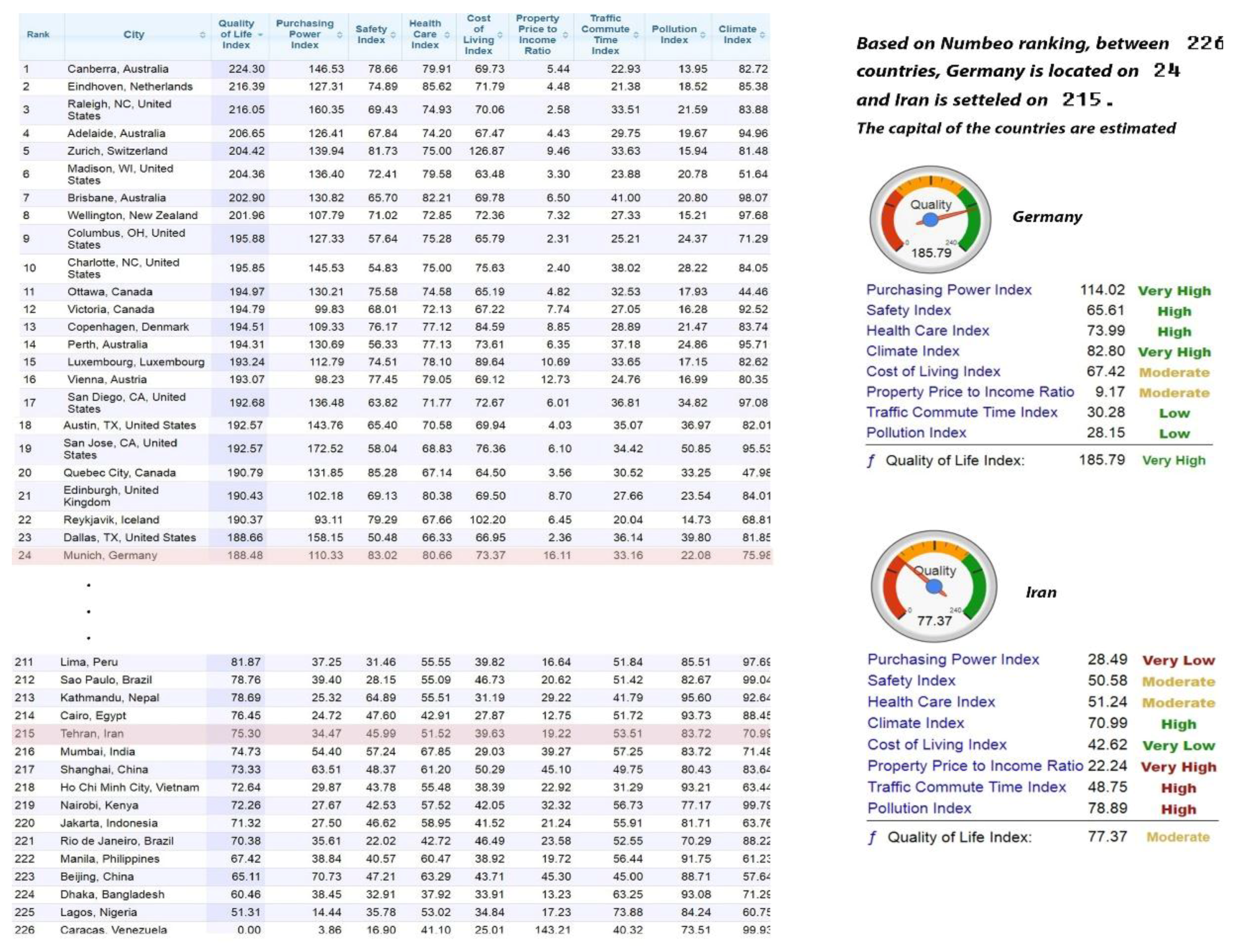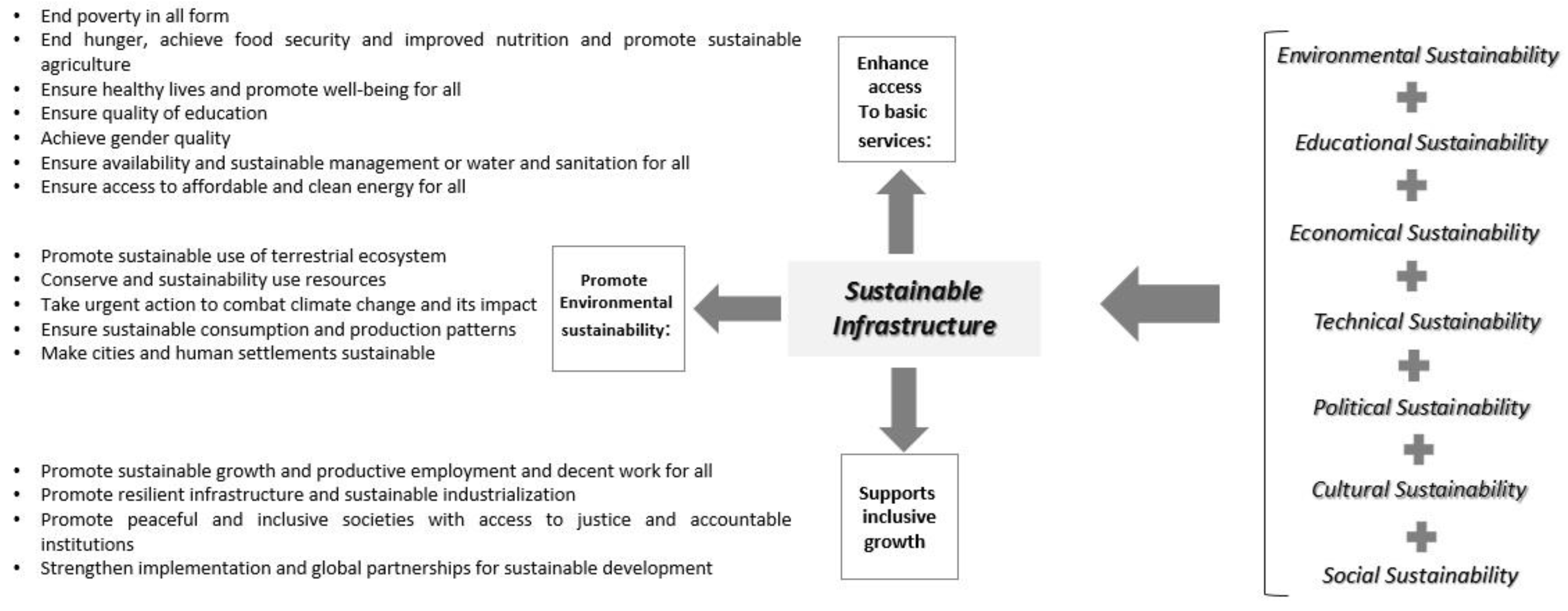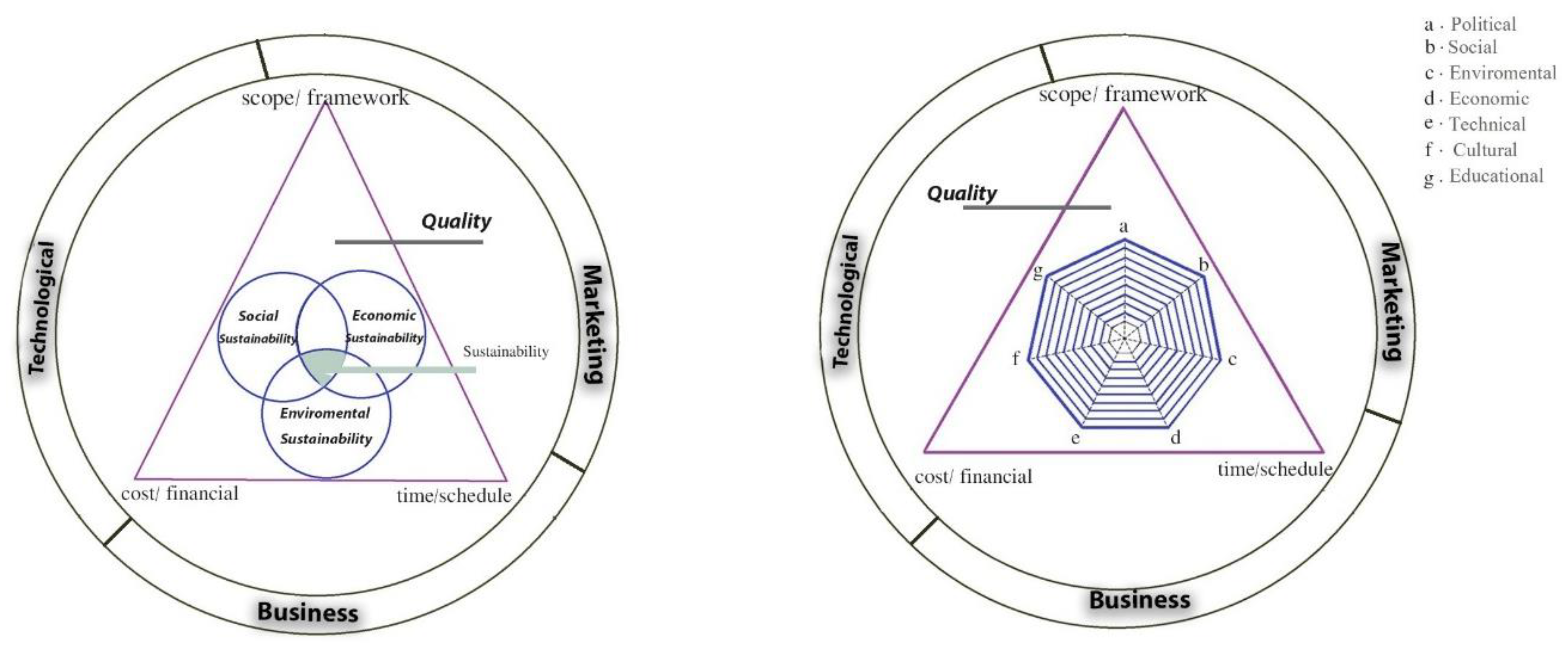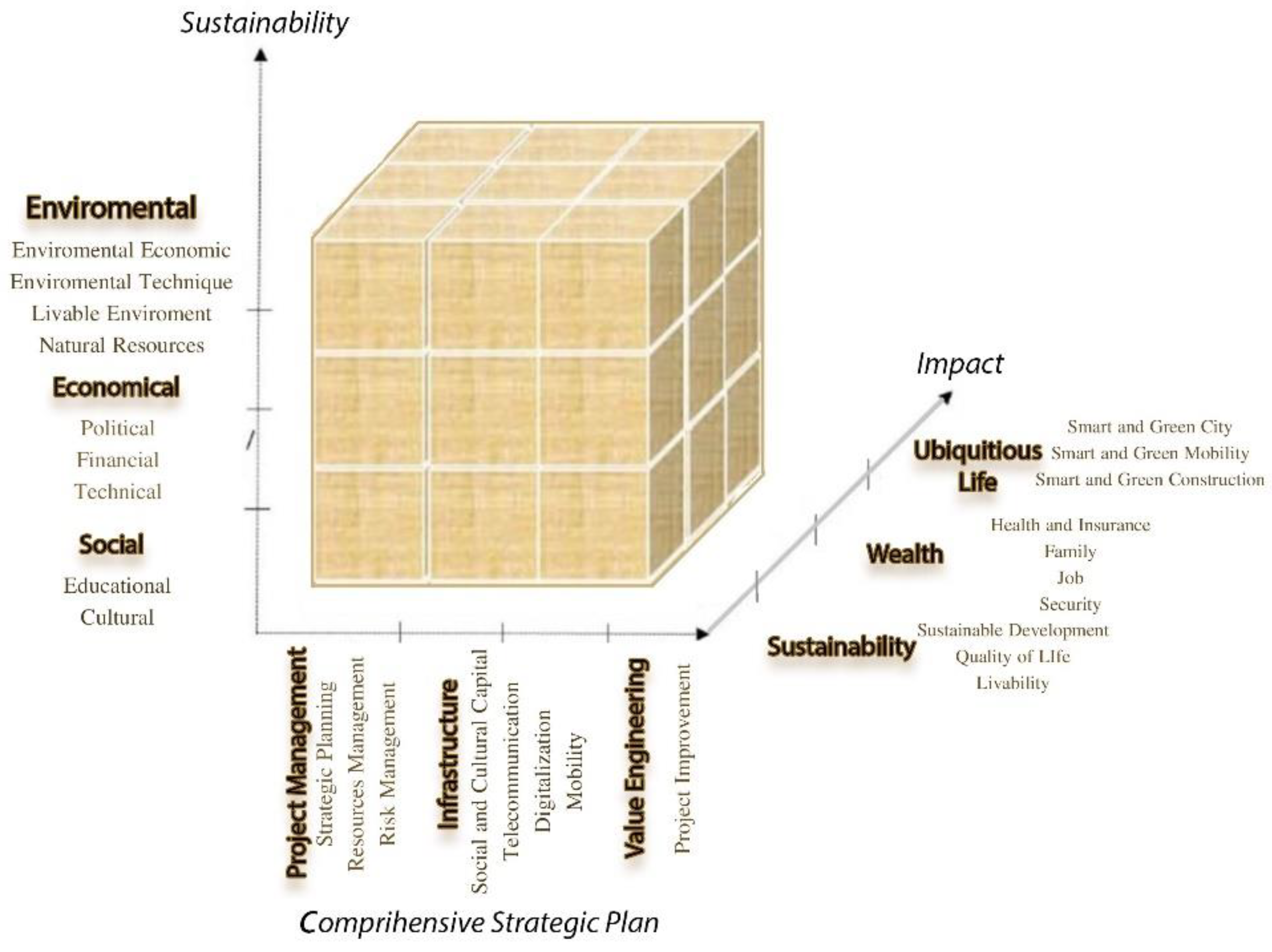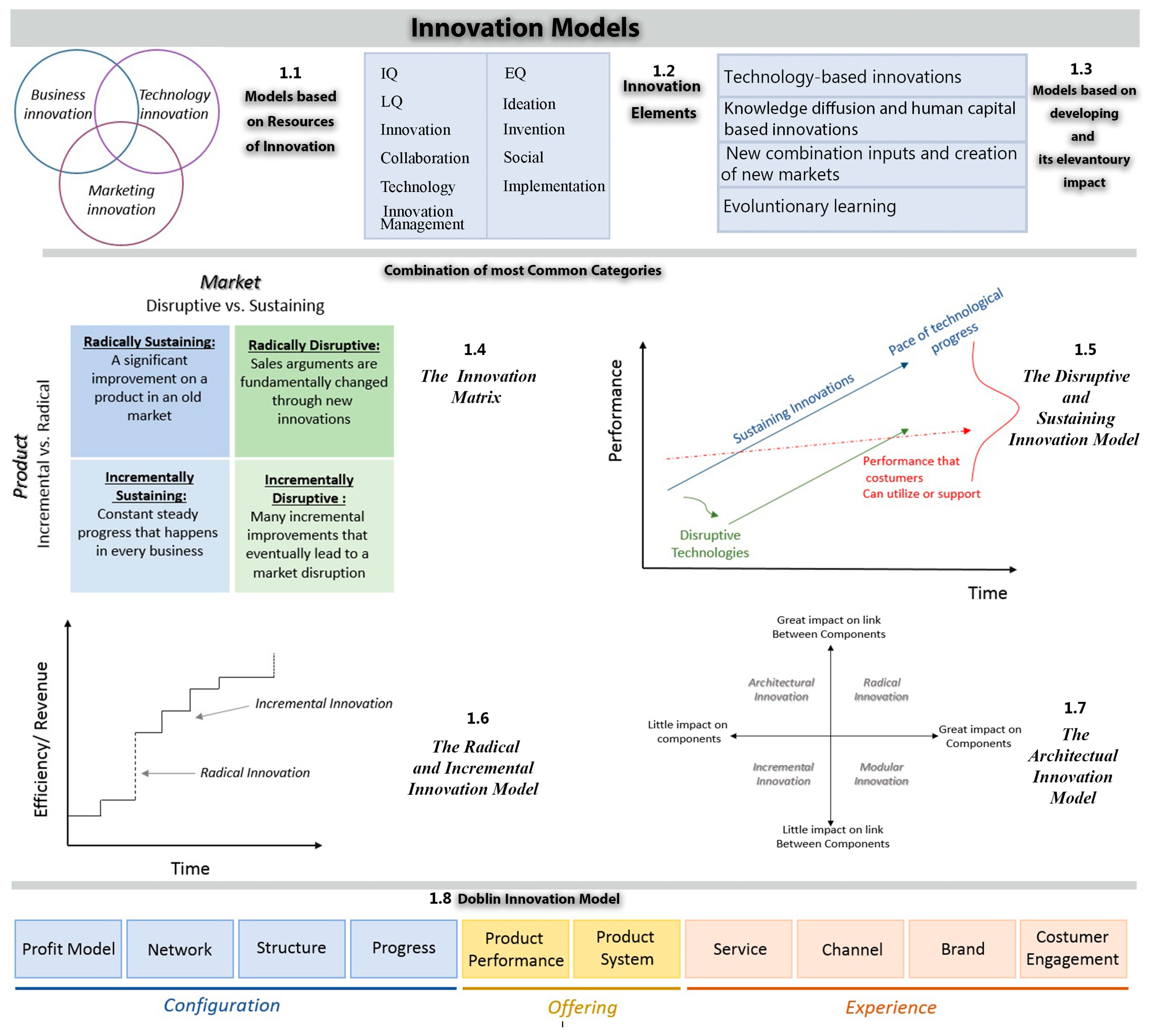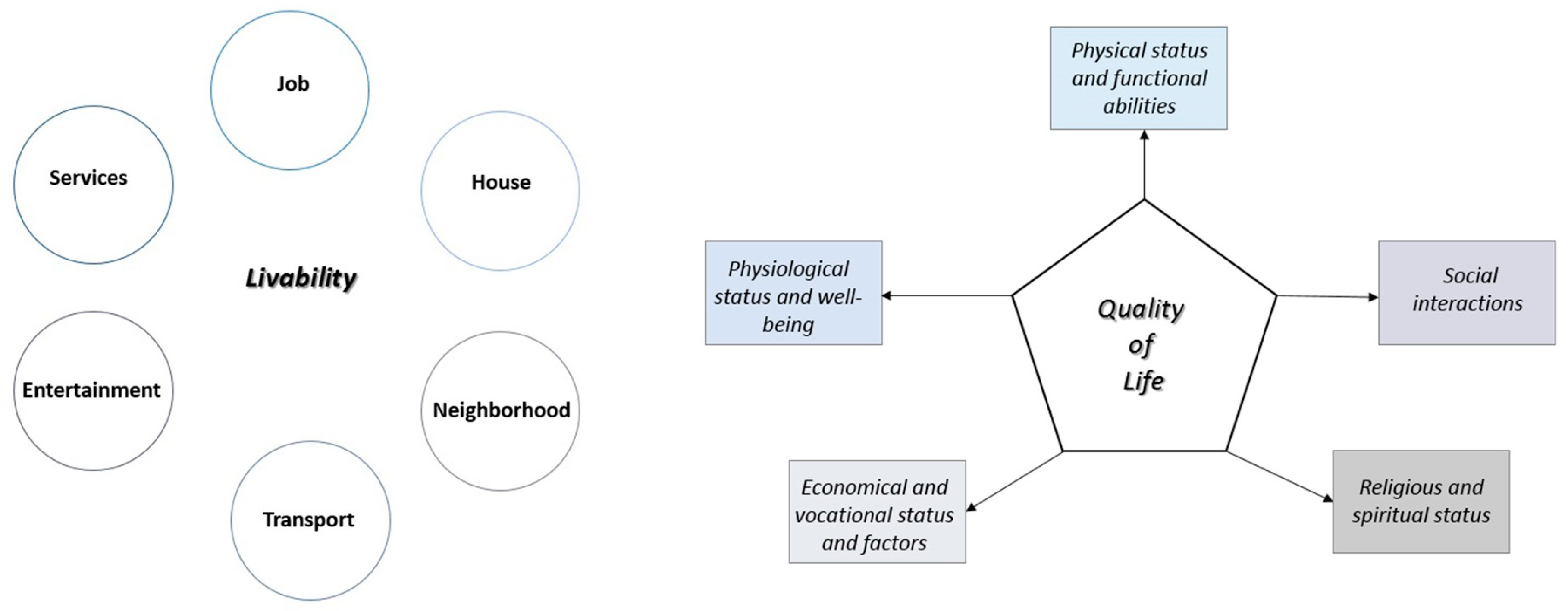1. Introduction
Nowadays, people are moving to cities to benefit from more opportunities such as jobs, better education, improved health, etc., in order to gain a better quality of life. Although people prefer urban life, rapid and unplanned urbanization causes a lot of problems such as poverty, slums, environmental problems, climate change, social instability, economic problems, and diseases. These problems are significant threats not only for the future of the world, but also for human beings. In particular, these challenges reduce sustainability and livability of urban life by disturbing nature, the environment, and increasing risks related to human beings.
Quality of life and livability are the most important parameters concerned with human life. Quality of life is about life satisfaction and livability is concerned with health, wealth, security, safety, education, job opportunities, public services, transportation, recreation, housing, and environmental quality. So, quality of life and livability are related to human beings and their lives. Therefore, it is important to improve quality of life and livability in urban settings. There is a relationship among quality of life, livability, and sustainability. In other words, achieving high sustainability and sustainable development are tools to create better urban settings through tackling urbanization challenges. So, achieving sustainability is a path towards a higher quality of life and livability. In general, to gain sustainability, proper techniques and tools are required. In recent decades, the role of project management in developing sustainability has been introduced.
Fundamentally, sustainability is needed to tackle urbanization challenges in order to create modern livable urban settings with a high quality of life. This phenomenon is one of the controversial issues these days. Several paths are introduced by researchers, planners, decision makers, and architects to develop sustainability. Based on the authors’ studies, high sustainability is recommended as a solution to struggle with urbanization challenges. High sustainability is different from traditional sustainability which has three components: social, economic, and environmental. High sustainability has seven pillars including environmental sustainability, political sustainability, social sustainability, educational sustainability, cultural sustainability, technical sustainability, and economic sustainability. In particular, some of these indicators such as education, regulation, and sustainability-based value creation were suggested as mechanisms for sustainability; however, the authors have realized that all seven pillars are required for developing sustainability.
These days project management is introduced as a path to achieve high sustainability. As Figgie and his colleagues declared, management is a technique to implement strategies and policies. So, management plays important roles in developing sustainability. Project management is required in urban planning to create a sustainable urban plan as a solution to struggle with urbanization challenges. In other words, project management such as risk management, is needed to plan a sustainable, comprehensive, and strategic urban plan to not only deal with infrastructure and urbanization challenges, but also develop high sustainability in urban areas.
In this research, innovative sustainable project management is declared as a solution to deal with urbanization challenges and create new urban settings with a high quality of life and livability. In addition, this solution is explored, and a model is proposed which is concerned with sustainable project management as the key to improve quality of life. In general, based on the current research, innovation is an accelerator tool to design successful project management. It means that innovation plays an important role in planning sustainable project management as a path towards sustainable urban areas.
The primary goal in this research is to suggest a model concerned with innovation, sustainability, and project management to improve quality of life and livability. In order to achieve the main goal, two sub goals are proposed. The first sub goal is to make an innovation model through suggested innovation models, and the second aim of the research is to determine the parameters and indicators concerned with quality of life and livability.
3. Methodology
To address the aims of this research, some questions should be answered:
How would sustainable project management improve quality of life and livability?
How would quality of life and livability be threatened?
What are the roles of innovation models in achieving goals of a project?
Why is innovation sustainable project management vital for the world in these decades?
In order to answer the research questions and achieve the aims of this study, it is important to pursue a sound methodology. In this paper three stages were developed to implement the study:
Stage 1: The development of a research methodology
This stage was developed on the basis of the literature review in the area concerned on objectives of this research. The authors have thoroughly investigated papers published in the context of innovation, innovation management, sustainable project management, livability and quality of life. In addition, the importance of sustainable urban areas with a high quality of life and livability was explored.
Stage 2: The development of the research tool
The research tool was developed on the basis of the relevant literature, exploring case studies, knowledge, and personal experience.
The purpose of surveys and case studies was to indicate policies, strategies, and solutions utilized by case studies in order to find out the roles of innovation, sustainable project management, and sustainable development in facing urbanization challenges.
In addition, the methodology of Kiwi and Kampenhood was used as a tool for analyzing. This method is used in social science, engineering, and management, and comes from Persian Zarathustra (good thoughts, good words, good deeds); it was selected as a methodology tool. In 2009, Hamid Doost Mohammadian used a dialectical thinking related to this methodology and designed a diagram to revise the method. In 2010 he translated it into English, although it is not yet officially published. Generally, the aim of this methodology is to find out factors influencing people’s well-being. This methodology is based on three levels with seven questions and analysis had been done through these questions.
Stage 3: Gathering the study results and analyzing
Based on literature reviews, surveys, case studies and analyses, some results were obtained and these results were analyzed and discussed by the authors.
4. Case Studies
As was mentioned, quality of life and livability are concerned with life satisfaction, health, wealth, security, safety, education and job opportunities, public services, transportation, recreation, housing, and environmental quality. Although some countries like Germany create a high quality of life through achieving these indicators, developing countries such as Iran cannot create a high quality of life and livability for its citizens.
In this study, two countries are selected as case studies: Germany and Iran (
Figure 6). Through different rankings (Economist, Mercer, Numbeo) Germany is ranked as one the most livable countries in the world; Iran’s quality of life is very low, and it does not exist in most rankings. Generally, two countries that are different in sustainability and livability are chosen to create a proper context to find out which indicators make differences in quality of life and sustainability. Although there are more sustainable and livable countries than Germany, it was chosen as a case study in this study. The main reason to select Germany was that this country will be more sustainable and livable in the future through utilization of proper strategies and policies. These policies and strategies can be studied and used by less sustainable countries, like Iran, in order to improve their quality of life. In addition, Germany is a country that was not always as sustainable as it is now. After World War II, Germany confronted a lot of problems that threatened the future of the country. Germany struggled with these challenges through proper strategies, policies, management, education and appropriate governance and created a sustainable country with a high quality of life and livability. Thus, it is a good example to show low sustainable countries that they are able to change their situation by utilizing strategies and policies. These were the two main reasons that Germany was chosen Germany as a case study. Furthermore, the second country was chosen as a less sustainable country in order to determine the reasons why some countries are more sustainable than others. Iran was selected as the other case study because as a low sustainable country, it is the hometown of the authors and they are aware of its conditions. So, it was chosen as the second case study.
4.1. Germany
Generally, quality of life in an urban setting in Germany is high. Education and skills, work–life balance, jobs and earnings, income and wealth, environmental quality, social connections, civic engagement, housing, personal security and subjective well-being make cities in Germany very livable.
Strategies used in Germany make livability and a quality of life possible. For instance, free education, high profitable insurance, appropriate and sustainable transportation, existing jobs and other opportunities made through strategies, waste management, utilizing corporate social responsibility (CSR) by companies and governments, help to create a country with a high quality of life. Further, some innovative strategies include utilizing waste as energy resources, renewable energy, water collecting, resource management and educating children in a proper way. These innovative solutions promote a high quality of life.
Another innovative solution which has made Germany sustainable in the economy is successful small and medium sized enterprises (SMEs). SMEs in Germany are responsible for almost 40% of total German gross investments and account for 30% of the country’s exports. Fundamentally, Germany is the second highest exporter in the world after China. According to high population of China, it could be declared that Germany is located at the first level of the export. More than 98% of companies in Germany are SMEs. This means that the economic situation depends on SMEs directly.
Innovative, entrepreneurial, and competitive international German SMEs focus on highly customized and specialized products and services via innovative strategies, high technologies, digitalization, productivity and exceptional vocational training system. SMEs can be used as tools to achieve sustainable development through productivity and growth of services, improving economic situations, enhancing social responsibility and social instability, reducing impacts of ecological footprint by innovative solutions concerned with green strategies in order to improve sustainability, more manufacturing, growth, job creation, international business and improving livability. Therefore, SMEs improve sustainable development. Truly, SMEs make Germany more sustainable with a high quality of livability and quality of life. Some factors for success of German SMEs are presented:
- ➢
Internal secrets:
- (1)
Innovative spirit-innovation-driven enterprises
- (2)
Flexibility
- (3)
Flexible work force
- (4)
SMEs think in generations, not quarters
- (5)
Loyal, well-trained staff
- (6)
Conservative financial conduct
- (7)
Hidden champions
- (8)
Regionally embedded, but internationally oriented
- (9)
Vocational training
- ➢
External secrets:
- (1)
Excellent regional education
- (2)
Adequate, regional financing, funding
- (3)
Well-developed infrastructure and high quality of life in rural areas
- (4)
Effective and competent local administrations
Therefore, strategies used by German SMEs are other solutions to make Germany a sustainable country with a high quality of life and livability.
Fundamentally, governments, companies, and businesses do their best to achieve needs concerning livability through proper strategies. In other words, urban and infrastructure strategic plans achieve sustainable development in the country as well as improve quality of life and livability.
4.2. Iran
Quality of life and livability is low in Iran. Livability is weighted by some main dimensions such as healthcare, stability, culture and environment, education and infrastructure quality. Fundamentally, these dimensions are low in Iran and the most important reason is improper strategies used by the government and businesses. For instance, income gaps lead to social instability and increase crimes in the country. So, security and safety become low and this directly influences livability in Iran. In addition, improper education reduces not only social and economic sustainability, but also environmental sustainability. For instance, skillful and expert capitals are required to create successful and sustainable businesses as the backbones of a country. So, education has an important role in improving the sustainability of a country. Political challenges such as sanctions disturb the sustainability of Iran. Exports and imports play significant roles in the economics of the country and sanctions weaken the export/import systems in Iran. So, one of the main backbones of the financial system becomes weak and creates significant threats to the economic sustainability of Iran. In addition, using old processes and management in businesses creates challenges for organizations to participate in the global market; this is yet another challenge that the economic system of Iran is confronted with.
In addition to these problems, environmental challenges such as air and water pollution, unsustainable infrastructure, poverty, slums, and depletion of resources such as fossil fuels are the main risks which threaten the future of Iran. The most important causes for Iran’s environmental challenges are:
- ➢
High consumption of fossil fuels instead of using renewable and clean energies
- ➢
Utilizing low-quality gasoline and benzene (because of sanctions)
- ➢
High household energy usage
- ➢
Utilizing old techniques to refine water and producing energy
- ➢
Inappropriate lifestyles and improper education about the importance of environmental sustainability
- ➢
Stereotyping and temporary solutions like canceling schools as a solution to air contamination
- ➢
Industrial challenges including old processes, using natural resources, wastes of industry, etc.
- ➢
Land mobility of dangerous and contaminated goods
- ➢
Infrastructure challenges like mobility and transportation problems
- ➢
Improper management
- ➢
Inappropriate comprehensive strategic urban plan
These are the main reasons for the environmental challenges that Iran is confronted with. In particular, nominated challenges make sustainability and livability in Iran worsen. These challenges prevent Iranians from having their needs addressed which causes the citizens to not be satisfied with their situation in life. So, there are significant threats for future of Iran. These challenges need to be addressed by utilizing proper management, strategies, policies, comprehensive strategic plans, education and cultural norms in order to create a sustainable country. In particular, strategies and solutions used by sustainable countries like Germany can help Iran become more sustainable. In addition, innovation, high technologies such as IT, ICT, IoE, IoB, digitalization, skillful capitals and smart citizens could be used as tools to create a sustainable country.
Fundamentally, it is vital to make the quality of life and livability better in Iran by addressing the risks which threaten the future of Iran and improving sustainability.
6. Discussion
In this section, results of the research are discussed:
6.1. Human’s Needs, Livability, and Quality of Life
Quality of life and livability are the most important parameters concerned with human life. Quality of life is about life satisfaction ranging from physical health, family, education, employment, wealth, safety and security to freedom, religious beliefs, and the environment; and livability is focused on health, wealth, security, safety, education and job opportunities, public services, transportation, recreation, housing, and environmental quality. So, quality of life and livability are indicators that are measured by quality of a human life and well-being.
Generally, quality of life and livability depend on human needs. Maslow’s hierarchy of needs presents how human needs could influence quality of livability and life (
Figure 7).
Maslow’s hierarchy of shows human needs including physiological needs, safety needs, belonging needs, esteem needs and self-actualization that are related to livability. It means that supplying these needs would influence livability and improve quality of life. So, there is a relation among human needs, livability, and quality of life. In general, to make a country livable and improve quality of life, it is necessary to obtain these needs.
If Maslow’s hierarchy is achieved, quality of livability and quality of life could be improved. When the highest levels of hierarchy are reached, a high quality of life is obtained. So, it is vital to find out the indicators concerned with Maslow’s needs in order to obtain them and improve quality of life and livability.
Nowadays, the world confronts a lot of problems, like urbanization challenges, that threaten human needs. These days, people are moving to cities to benefit from better jobs, education, economic, health, wealth and other opportunities. Generally, people prefer urban life to rural life because they have better opportunities in cities to improve their quality of life. However, the increasing population of cities poses significant threats to urban life and can lead to dissatisfaction by disturbing the different aspects of Maslow’s hierarchy.
Through growing urbanization, Maslow’s hierarchy of needs can face many difficulties. It means that urbanization problems such as poverty, slums, health diseases, environmental challenges and climate change, unemployment, social instability and others are directly related to Maslow’s hierarchy of needs and could compromise quality of life in human beings. For instance, urbanization causes challenges concerned with supplying safe food, clean water, housing facilities, security, safety and sufficient energy as physiological needs. Generally, natural resources such as fossil energy resources will be depleted in the near future and it could influence the supply and demand. Further, fossil energy makes pollution and harms the environment and urban setting. In addition, economic problems such as unemployment, poverty, and economic instability as well as challenges related to public utilities will occur, just as Germany confronted economic challenges after WWII that were significant threats for this country. German SMEs struggled with economic problems but created one the most sustainable economic systems in the world.
Fundamentally, urbanization challenges prevent Maslow’s needs from being achieved. This leads to people’s dissatisfaction with their life, and quality of life and livability are reduced. Therefore, it is important to find solutions to struggle with these challenges to obtain Maslow’s needs in order to improve quality of life.
Generally, Maslow’s hierarchy of needs should be gained to create livable urban areas with high quality of life. Therefore, it is vital to find out solutions to achieve human needs through dealing with urbanization challenges.
6.2. Sustainability and Human Needs
In recent decades, rapid and unplanned urbanization has caused a lot of problems that threaten the future of the world and human beings. For instance, environmental challenges, climate change, depletion of resources, and health challenges not only lessen quality of livability but also the future of the world for people. So, solutions should be utilized to deal with these problems and supply human needs.
Human needs could influence on the quality of human life. In other words, if human needs based on Maslow’s hierarchy of needs are not gained, quality of life and livability could decrease which then makes citizens dissatisfied about their lives. This is an important menace for the future of human beings. As was mentioned before, the path towards supplying human needs and tackling urbanization challenges are needed.
One of the best solutions determined in recent decades to struggle with urbanization is sustainability and sustainable development. Sustainable development can be used as a tool to manage and maintain natural resources, use renewable energy, reduce environmental challenges such as air pollution, water shortage and others, improve economic situations, and promote social responsibility, security and social stability. Sustainability can influence a city’s infrastructure like transportation, mobility, economic, social stability, security, job and education opportunities, health, and environment and create sustainable infrastructure (
Figure 8). Sustainable development and sustainable infrastructure supply Maslow’s needs. So, sustainability can improve quality of life and livability through sustainable infrastructure. Fundamentally, a sustainable city is the solution to supply Maslow’s needs and improve livability in an urban setting.
Sustainability is not sufficient to create sustainable livable urban areas. In other words, sustainability needs other tools in order to tackle urbanization challenges and supply human needs to create modern urban settings where high sustainability makes a high quality of livability and thus citizens are satisfied with their lives.
6.3. Innovative Sustainable Project Management
In addition to sustainability, other techniques are required to deal with urbanization challenges in order to create sustainable livable urban areas. Based on the authors’ researches and analyses, sustainable project management could be used as a proper tool.
Project management is able to balance time, scope, and cost regarding quality. Thus, project management helps projects be successful. In addition, it could be a tool to develop sustainability.
Generally, project management would help projects be sustainable through resource management, strategic plans, and risk management.
Resource management focuses on natural resources, capital resources, human resources, financial resources, agricultural resources, and generally resources related to land, labor and capital resources in a country. Resource management includes acquiring, allocating, and managing resources. It is used to improve efficiency and profitably of businesses. In addition, it is a key to improve environmental challenges. Generally, the first step in project management is resource management required for proper planning.
Strategic planning is another element of project management. It is concerned with an organization’s goals. Strategic plans could help businesses, organizations, and governments to achieve their goals. A proper strategic plan is concerned with financial, environmental, social, cultural, educational, technical and political aspects as well as CSR. In other words, strategic plans should focus on all aspects of sustainability to achieve its goals.
Risk management is needed to analyze risks related to strategic plans and reduce project failure. Generally, four types of risks such as project risk management (PRM), financial risk management (FRM), enterprise risk management (ERM), and government risk management (GRM) should be utilized to reduce failure of a project and gain the best results.
Sustainable innovative project management is required to make policies, strategies, solutions, and keys to gain the best result and sustainability through project management.
Sustainable project management is about changing policies, strategies, assets and organization concentered on all aspects of sustainability, in order to deal with urbanization problems in order to improve quality of livability and life.
To gain sustainable project management, accelerators like innovation play important roles. Innovation is not only about new ideas, but it is also concerned with the improvement of the process. Innovation can help change and improve project management strategies. In other words, innovation can influence and improve project process, strategies related to sustainable development, and elements of project management. Generally, innovation uses external and internal opportunities and creativity to improve old processes or introduce new concepts as new processes. In addition, innovation can create new models related to sustainability, project management, and quality of life. These models can help countries, especially developing countries, to overcome their problems and improve their quality of life and livability in the best and fastest way. Although sustainable project management is a proper tool to improve quality of life, sustainable innovation project management is a better tool that gives results faster and in the most precise way.
Fundamentally, innovative sustainable project management is introduced as a solution to create modern urban areas in order to improve quality of life and livability. Based on this solution, a model is proposed.
DR-ISPM is introduced by the authors as an innovative sustainable project management model. This model shows that required sustainability aspects are located in the project triangle.
The aim of management is to make a balance among time, cost and scope to gain the best quality. When a project is parallel with social, economic, and environmental sustainability, then sustainable project management is achieved. In other words, if management is aligned with sustainability aspects, sustainable project management will be gained. In addition to sustainable project management, innovation in business, marketing and technology could play roles in creating innovative solutions. As was mentioned, to gain sustainable project management, accelerators like innovation and high technology are required. According to this model, sustainability and management created through innovation could create a path towards a high quality of livability and life. Fundamentally, this model could be used as a strategy in a comprehensive strategic urban plan to work with sustainability in order to design modern sustainable and livable urban settings.
The
Figure 9 presents the DR-ISPM model as a theory to improve quality of life and livability through sustainable innovative project management.
6.4. Towards Sustainable Livable Urban Settings
Sustainable livable urban setting is the best solution to improve quality of citizens’ life through reducing the impacts of urbanization challenges. Alongside sustainability, other tools and techniques are required to achieve sustainable development and design such modern areas.
The other tool needed for creating such areas is a comprehensive strategic urban plan including project management, infrastructure, and value engineering.
Based on these two indicators (sustainability and comprehensive strategic urban plan), the DSR (Doost Mohammadian, Sustainability, Rezaie), model as an innovative solution to create sustainable livable urban areas is presented by authors. This model was introduced by the authors at the sixth International Conference on Civil, Architectural and Environmental Sciences as a new concept for urban living. Generally, it presents that sustainability and a comprehensive strategic plan (project management is an element of it) could create new urban settings with a high quality of life, livability, and sustainability. According to this theory, besides sustainability, project management and innovation, other tools such as infrastructure including technology, digitalization, mobility, social and cultural capital and value engineering are required to achieve sustainability and high quality of life in an urban setting.
Fundamentally, this model is concerned with utopia cities needed for a high quality of human life. Such cities are not only aligned with sustainable development, but also are creating areas with a high livability through supplying human demands. Utopia cities are based on sustainability, wealth and ubiquitous life that are able to struggle with urbanization challenges, supply human demands, and improve the livability of citizens.
The DSR model is an innovative strategy to create a modern urban area for living through sustainability and a comprehensive urban plan. Sustainable innovative project management is introduced as one of the tools to design a proper strategic plan.
The
Figure 10 presents how sustainable livable urban settings could be created:
Based on this theory, innovative sustainable project management is just one of the tools required to create sustainable livable urban areas. To design such modern areas different tools such as blue-green strategies based on environmental sustainability, successful SMEs to develop economic sustainable, and vocational training towards sustainable education are needed to create sustainable urban areas with high quality of livability and life that could investigated in future studies.
6.5. Challenges and Solutions
The most important challenges that the world confronts is risks that threaten quality of life and livability of the world. It is declared that urbanization challenges are the main reasons for these risks. These challenges make it difficult to supply human needs, deplete resources, create health challenges, instability, insecurity, environmental challenges, etc., which lessen the quality of livability and life. So, it is vital to find out solutions to tackle these risks.
Creating a sustainable and livable urban area and sustainable development are realized as the main solutions. Paths to design such areas should be investigated. In this research, innovative sustainable project management is introduced as a tool to design such modern cities.
7. Conclusions and Future Studies
Nowadays, quality of life and livability are endangered in urban settings through urbanization. A rapid and unplanned urbanization creates severe problems, especially if planning efforts cannot cope with the influx of new inhabitants. The spread of disease, potential water crises, and risks to critical infrastructure, climate change, economic difficulties and social instability are the most important problems which could threat people’s lives. These problems have impacts on quality of life and livability and make them worse by disrupting human needs based on Maslow’s pyramid. So, it is vital to struggle with urbanization challenges in order to improve quality of life and livability. Sustainable development is the best solution to improve livability in urban settings. Based on the authors’ researches, creating a modern, sustainable, and livable setting is the path to achieve sustainable development. Such areas are able not only to achieve sustainable development to improve quality of life, but also to make the world a better place for living.
Suggested urban areas are based on sustainable infrastructure that is related to sustainable designing, building, and operating in ways to develop sustainable social, economic and ecological processes that are required to maintain human equity, diversity, and the functionality of natural systems. In particular, sustainable and livable urban areas provide opportunities to improve quality of life and livability. To design such areas, different parameters like sustainability, comprehensive strategic urban plans, and high technologies are required. It is considered that sustainability, urban planning and good governance with effective regulatory frameworks could deal with urbanization challenges, improve the supply of human needs, and generally enhance quality of life.
In this research, innovative sustainable project management is introduced as a tool to design modern sustainable and livable cities.
In this research, models concerned on innovative sustainable project management are proposed as keys to struggle with these problems. Good governance and management provide appropriate infrastructure and public services, which range from the capacity to contain infectious disease to the challenges of building climate-resilient cities. Therefore, sustainable project management is a proper solution to deal with urbanization problems. In addition, innovation could help project management to improve its goals by creating new ideas or improving old processes. Fundamentally, innovation creates the best and fastest ways to improve quality of life. The DR-ISPM model as a theory to gain innovative sustainable project management is introduced in this theory. In addition, the DSR model as a strategy to create modern sustainable and livable urban areas with a high quality of life is presented. It is realized that such areas are the best solution to struggle with urbanization challenges in order to develop sustainability and improve livability and quality of life towards a better setting for living.
There are several limitations and shortcomings of this paper. The setting and managing of interview appointments was a problem which leads to a delay in the schedule of the research. In addition, due to the short timescale of the research in regard with the research area, the authors might not be able to study enough in the field, which might bring a broader view to the issue. Based on broader research, there are more issues and indicators related to quality of life and livability that are not be mentioned in this study. Furthermore, exploring more case studies could provide more strategies about how to improve quality of life and livability in urban settings.
There are more innovative models like the TRIZ algorithm and IMP3rove as innovation management that are not explored in this research. In future studies these models could be probed, and innovative models based on them could be designed as a new solution to improve quality of life and livability. Interviews and questionnaires will be added to future researches as a tool to gain more reliable data about this phenomenon. In addition, other tools named in this research such as a comprehensive strategic urban plan could be explored in future studies.
